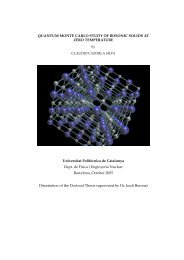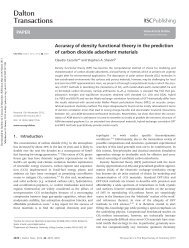Journal of Low Temperature Physics 171, 619 - DR. CLAUDIO ...
Journal of Low Temperature Physics 171, 619 - DR. CLAUDIO ...
Journal of Low Temperature Physics 171, 619 - DR. CLAUDIO ...
Create successful ePaper yourself
Turn your PDF publications into a flip-book with our unique Google optimized e-Paper software.
J<strong>Low</strong>TempPhys<br />
1 Introduction<br />
The interest in graphene as a structure formally derived from graphite has risen lately,<br />
due, among other things, to the possibility <strong>of</strong> using it as adsorbent. Studying the<br />
physisorption <strong>of</strong> H 2 on C-surfaces has the additional interest <strong>of</strong> assessing whether<br />
these surfaces could be used as reservoir in fuel cells. To do so, a certain amount<br />
<strong>of</strong> hydrogen has to be captured by the substrate. Hence, an ideal structure will be<br />
the hydrogenated version <strong>of</strong> graphene, which has been called graphane. In graphane,<br />
each carbon forms a covalent bond with a hydrogen atom. The existence <strong>of</strong> graphane<br />
was theoretically predicted by S<strong>of</strong>o and collaborators [1], who proposed two different<br />
types <strong>of</strong> graphane, the chair graphane (C-graphane) and the boat one (B-graphane).<br />
Elias and collaborators [2] were able to synthesize the chair graphane in 2009. In 2010<br />
a third type <strong>of</strong> graphane, the washboard graphane (W-graphane), was predicted [3].<br />
Here, we present zero-temperature calculations <strong>of</strong> the phase diagrams <strong>of</strong> H 2 adsorbed<br />
on the three different types <strong>of</strong> graphane, using the diffusion Monte Carlo technique.<br />
The aim <strong>of</strong> this work will be to compare those diagrams to those obtained on<br />
graphene and estimate the weight percentage <strong>of</strong> H 2 that can be adsorbed on top <strong>of</strong><br />
these novel structures.<br />
The plan <strong>of</strong> this work is as follows. In Sect. 2 we will describe the computational<br />
method used in our calculations, indicating the parameters and auxiliary hypotheses<br />
necessary to carry out the simulations. In Sect. 3 the simulation results will be<br />
discussed and lastly, Sect. 4 will present our conclusions.<br />
2 Method<br />
In order to obtain the zero-temperature phase diagrams we have to solve the manybody<br />
Schrödinger equation for a set <strong>of</strong> H 2 molecules adsorbed on graphane. The<br />
diffusion Monte Carlo method makes this possible for a system <strong>of</strong> bosons, such as<br />
the para-H 2 molecules considered here. The starting point <strong>of</strong> the method is the trial<br />
function, an initial approximation to the ground state wave function <strong>of</strong> the system.<br />
To simulate a liquid arrangement, we have to use the translational invariant. In this<br />
work, this means,<br />
Ψ L (r 1 , r 2 ,...,r N ) = ∏ i





